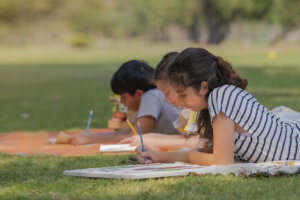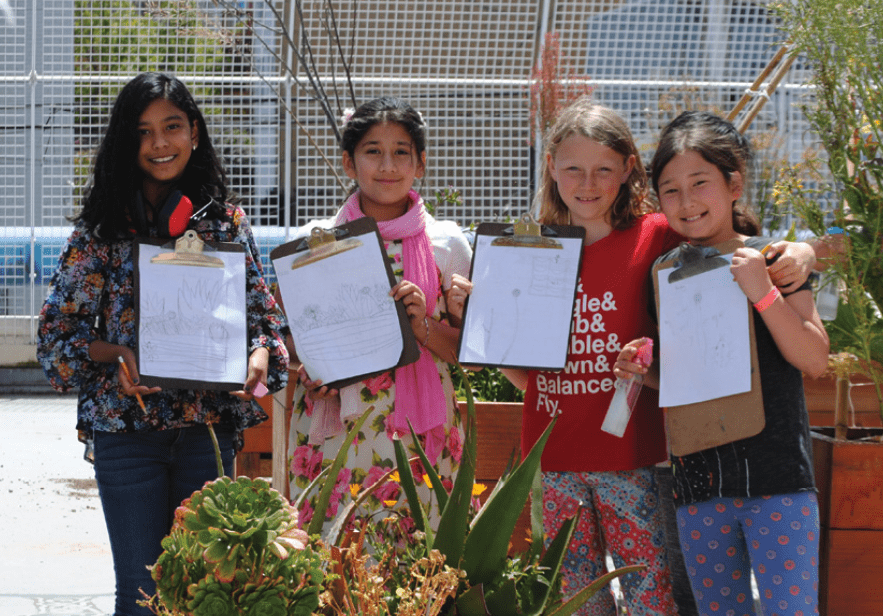Change and transition are integral parts of growth and progress, offering initiatives an opportunity to welcome fresh ideas, perspectives, and innovation. For CAELI, change is a catalyst for renewed purpose and additional impact. In the wake of a recent executive committee retreat, the newly elected co-chair, Estrella Risinger (she/her), and current co-chair Juanita Chan-Roden (she/her), are excited to bring a fresh perspective to the future of CAELI.
In this interview, Juanita and Estrella discuss how they hope to guide and support a growing network of environmental literacy advocates, and Estrella dives into the challenges and opportunities of this new role and the reasons behind her passion for environmental literacy.
What most excites you about stepping into the role of co-chair?
Estrella: I’m most excited by the incredible opportunity to guide and support a growing network of environmental literacy advocates. The work of the CAELI network is so critical, and I am thrilled to have the chance to enhance my skills and strengthen my connections across the network. My goal is to foster collaboration and maximize our collective impact.
As co-chairs, we work closely with the Ten Strands team to shape and support the network. By drawing insights from network leaders, we can identify the needs, challenges, and opportunities for the network to grow.
Specifically, co-chairs do a lot of on-the-ground planning and strategizing with the Ten Strands team on how to leverage our connections and drive systems change. From my perspective, the co-chairs help provide the glue that holds the CAELI network’s pieces together. Ten Strands provides essential backbone support and we strive to represent the network, bringing together diverse perspectives and showcasing the work being done by innovation hub leaders and the groups they collaborate with.
Juanita, what were some things about Estrella’s leadership style and background that made her stand out as a candidate for this role?
Juanita: Estrella has demonstrated her leadership skills in the past as the co-chair of the Community-Based Partner Innovation Hub. Estrella’s transformative work with that innovation hub showed us her ability to provide clear direction and bring about positive change. Furthermore, Estrella’s passion and extensive knowledge of outdoor education and excellent communication skills made her the best candidate for this role at this time.
In addition, Estrella quickly demonstrated her capability to bridge relationships between people, showing that she could bring people together and align them toward a common goal.
Estrella, what led you to become an advocate for environmental literacy?
Estrella: My journey toward becoming an advocate for environmental literacy began with my early experiences in nature. As a child, I was fortunate to have continuous access to the outdoors. My father ran a nature-based summer camp, and every summer I had the opportunity to explore various natural landscapes in California, such as the Mendocino coast, the redwoods of Big Sur, and the mountains in the Sierra. These experiences had a profound impact on me, fostering a deep connection to the natural world and a sense of community with others who shared a similar appreciation for it.
Over the years, these cumulative experiences solidified my passion for the outdoors and instilled in me a desire to ensure everyone has access to such transformative experiences. I believe that spending time in nature and engaging with it in a communal setting can be incredibly impactful, allowing us to develop a stronger connection with ourselves, each other, and the planet.
In recent years, I have witnessed the stresses of the pandemic, ongoing mental health crises, and the disconnection from nature caused by the constant pressures of consumerism and individualism. These challenges have made it even more crucial to emphasize the importance of reconnecting with the natural world. Experiencing curiosity, wonder, and joy in nature can help foster the knowledge and connections necessary to address pressing issues like the climate crisis and systemic racism, which are deeply intertwined.
For me, it was the combination of those initial transformative experiences in nature that exposed me to humanity’s role in nature. I realized the complexity of these systems and the need to foster a deeper understanding among individuals to address environmental challenges effectively. By advocating for environmental literacy, I aim to inspire others to appreciate and protect the natural world, fostering a sense of responsibility and resilience in the face of the environmental crises we are currently experiencing.
What are some of the things that you find most challenging about this work?
Estrella: One of the most challenging aspects of this work is the perceived disconnect between environmental education and people’s daily lives. Our educational system has created a distance between curricula and its real-life application, which poses a significant barrier. It can be disheartening to hear people view environmental education as merely a “nice-to-have” addition, with field trips being the first thing to be cut due to resource constraints such as time, transportation, and funds. Unfortunately, it is our children who miss out on these enriching experiences, not only in terms of connecting with the natural world but also in understanding the relevance of environmental issues to their own communities.
Educators recognize the importance of bringing in a more culturally relevant approach to environmental education, as it is through understanding environmental justice that we can address systemic barriers. Empowering communities to push back against these injustices is crucial, but it can feel challenging to navigate these topics without overwhelming students or fostering apathy, particularly when addressing the climate crisis.
What makes you optimistic about the future of this work?
Estrella: Despite the challenges, there is also immense opportunity for growth and positive change. When students genuinely care about what they are learning and find value and meaning in it, their engagement increases; for example, we see this with students when they write letters to local officials and speak in public forums. By emphasizing stories of resilience, resistance, and action, we can inspire students to take an active role in environmental issues.
Looking ahead, there are reasons for hope and optimism. For example, Ten Strands’ work in curriculum development, which focuses on climate and environmental justice, provides an excellent opportunity to develop relevant curricula in collaboration with experts working in their communities. By ensuring that teachers have access to this curriculum and providing them with the necessary support, we can tap into the tremendous potential for positive change. It is inspiring to see the diverse voices and perspectives that have come together through initiatives like CAELI to advance this work. By broadening the movement and including more voices and changemakers, we can make a significant impact on environmental education and create a more sustainable future.
Juanita, same question for you: What do you find most challenging and most hopeful about this work?
Juanita: For me, one of the most challenging aspects is effectively communicating the urgency and importance of addressing environmental issues to communities. While the environmental community has done a commendable job in highlighting the problems, there is still much to do in regard to educating people about the things they can do to solve these problems. It is crucial to move beyond fear-mongering and emphasize that real solutions require a fundamental shift in human behavior. Just as we discuss physical and behavioral adaptations in the context of the natural world, as a human species, the urgency to adapt is more important now than ever.
Within the K–12 education system, numerous challenges arise. The scarcity of time is a primary challenge, but another significant hurdle is making education relevant to students. We need to question why we teach certain subjects and why they matter. In the past, the purpose of education was often aligned with preparing individuals for industrial work. However, as society has evolved, our education system must adapt to teach children how to think critically. Today, the skills children need to prepare them for the future means encouraging them to think innovatively and recognize the value of technology as a tool. The adults in the education system must shift their perspectives and support this transition, providing relevant and engaging content that prompts deep thinking.
Despite these challenges, there is also great reward in this work. Our biggest opportunity lies in teaching all adults within the education system that traditional skills alone are insufficient for the problems of the future. We must equip individuals with the ability to utilize these skills effectively in solving complex issues. Our future as a species on this planet necessitates a comprehensive approach that includes empathy. Teaching empathy means fostering care not only for oneself and close friends but also for the wider community, including nature itself. Inspiring a sense of love and appreciation for the environment becomes a vital part of the educational journey.
What do you both hope to accomplish as co-chairs over the next couple of years?
Juanita: My main goal and hope for the next couple of years is to drive radical change. Currently, I’m a year in as co-chair, and in that time, we have defined our organizational structure and direction. Now I’m looking forward to seeing the innovation hub projects through and seeing an increasing number of creative projects emerge.
I believe in the power of praxis, where we learn and adapt during the process of implementation. It’s through this experiential learning that we can identify and overcome barriers that hinder progress. Over the next couple of years, I am excited to witness such transformative learning unfold.
In the past year, we were able to spark conversations with various county offices of education. This success demonstrated the power of our network and the value it brings to those doing the work on the ground. By providing a platform for collaboration and knowledge sharing, we enable educators to accelerate their progress and avoid reinventing the wheel. I anticipate exponential growth in the coming years as more stakeholders speak the same language and align their administrative regulations and board policies. Furthermore, I expect to see increased engagement with families as we provide relevant education within their communities.
Estrella: I am thrilled about the current state of CAELI. The incredible momentum we’ve seen, along with the strong foundation we’ve built, is putting us in a position to expand in a powerful way. As a leadership team, we’ve been having discussions on how to bring in more voices and involve a broader range of people. The environmental movement has been fairly insular, limited to conversations with the same individuals and legislators. However, we stand at the precipice of a transformative opportunity to make a broader impact and reach a wider audience.
To achieve this, we envision collaborating extensively and forming meaningful partnerships to strengthen environmental literacy through school facilities, curriculum, policy, etc. By addressing these different components, we can positively influence students’ experiences and inspire systemic change.
What was the most notable thing to you from the recent executive committee retreat?
Juanita: For me, the most notable thing was the emphasis on the significance of relationships in education. Everything we do in the field of education revolves around building and nurturing relationships. While virtual interactions are valuable, being able to connect face-to-face and share the same physical space allows for a unique exchange of energy and purpose.
During the retreat, one of the most powerful tasks we engaged in was identifying the levers of change within the K–12 system. This exercise aimed to determine how we can drive meaningful and impactful transformation to benefit all students in California. By analyzing how these levers interact with one another, we could identify challenges and opportunities for growth.
Additionally, we established a clear vision for the upcoming 2023-24 academic year. Recognizing the need for change, we also addressed the importance of reorganizing our calendar and mindset around annual outcomes. This shift in thinking is crucial if we are to effectively bring about positive change in the education space.
Estrella: Juanita also touched on this, but the informal setting provided a unique opportunity to learn about each other’s personal lives, such as sharing stories about our dogs, discussing the latest movies we’ve watched, or even sharing inspiring articles we’ve come across. Moreover, we delved into the fears we hold concerning the climate crisis, and touched on the personal impact of anti-LGBTQ legislation in various parts of the country. By sharing these personal stories, we gained a deeper appreciation for how these issues affect us individually and how they influence our ability to contribute meaningfully. These conversations are not typically facilitated over virtual platforms like Zoom, underscoring the value of in-person interactions. The dedicated time we spent together allowed for a richer, more nuanced understanding of our relationships, fostering trust and vulnerability. Such connections are essential for effective collective action, enabling us to forge a deeper bond with one another.








